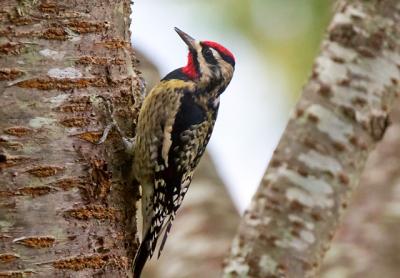Nature Notes: ‘. . . Oh Why, Can’t I?’

The post-noon photoperiod will lose an hour on Sunday, while the winter solstice is only 50 days away. Any day now the lawn will be coated with gray upon waking, and frosts will soon become an everyday phenomenon.
It was a little above 50 degrees at 3:30 in the afternoon when a Carolina wren began singing outside my window. Such will even happen during subfreezing temperatures in the middle of winter. Does he miss the Carolinas, or was he just trying to cheer me up?
This sparrow-size bird has been in these parts since the late 1960s. In late December of 1974 I was a member of the late Roy Wilcox’s party counting the birds by number and species in Noyac as part of the Orient Christmas Bird Count. In the late afternoon, Roy took us to a spot a little east of the Elizabeth Morton Wildlife Refuge, stopped the car on a side street a bit north of Noyac Road, and asked us to listen carefully.
In those days we didn’t have devices to play the songs of the birds to get them to call back. After about five minutes of absolute silence, it started, loud and clear. The repetitive but cheery sound of the Carolina wren rolled across the lawn to our ears. I had been living in California until that fall and it was the first time I ever heard a Carolina wren sing. Thereafter, on almost every Christmas count on eastern Long Island, I listened for that loud repetitive song and ultimately heard it.
The time of the annual Audubon bird counts that now take place across the world is approaching. Most summer-resident birds are gone, but a few linger, especially when the weather is fall-like and not winter-like and while wild fruit and insects remain and while birdfeeders are hung up and filled with seeds and other goodies. Kinglets and goldfinches are among the last to leave for warmer climes. Until Saturday’s northeaster there had been a male golden-crowned kinglet in my tiny yard feeding on aster and goldenrod seeds, a few of which are still flowering along with one of my tall evening primroses. I have not seen him since.
One of our most beautiful birds, the male yellow-bellied sapsucker has been hanging around, too. Occasionally, one will show up on one of the winter counts. If you’ve never seen one, I’m sure you’ve noticed its “footprints” on the trunk of the occasional tree. The sapsucker is the woodpecker that “drills” Cheerios-size holes in neat rows both up and down and across in order to find nutritious sap to feed on (and insects, too?). Terry Sullivan photographed a male at his feeder in eastern Sag Harbor the other day, and on Saturday Jean Held found one lying on the sidewalk on the north side of the Corner Bar on the corner of Main and Bay Streets in Sag Harbor.
Apparently, it flew into one of the large windows on that side of the building. It is not unusual for a bird to fly into a window, especially when pursued by a hawk. In most cases the fleeing bird is stunned and sometimes injured, but rarely killed by the impact. The rule is to pick the bird up and put it in a cardboard box covered over with a towel. If the bird is okay, it will recover after several minutes and will fly away when the towel is removed. If it is injured, the local number to call is 631-728-WILD, the Evelyn Alexander Wildlife Rescue Center in Hampton Bays, which treats injured birds.
Jean says the best remedy for decreasing the number of bird-window collisions is to have the window glass facing down at a slight angle. People also post decals to the window’s inside in order to deter window strikes.
In the song “Somewhere Over the Rainbow” from “The Wizard of Oz,” Judy Garland notes that birds fly over the rainbow and wonders why she can’t as well. Humans are good at a lot of things but we can’t fly under our own power. Bats are the only mammals that fly like birds.
A New World warbler, or vireo, the size of a house mouse can fly 1,000 miles, not all at once, but within a week or two during migration time. It has been documented that a hummingbird, half the size of a warbler, can fly across the Gulf of Mexico in one trip. In this sense, birds are miraculous. They are not only colorful, they sing beautifully and fly astutely over long distances. In my 83 years on earth, I have never heard of a single case of one of these miraculous creatures killing a human. On the other hand, I have witnessed hundreds of bird killings by humans, some by my own hand. If we don’t kill them ourselves, we build tall buildings they fly into, we erect wind turbines that knock them from the sky, we apply all sorts of poisons to our food and ornamental plants, and so on, and so on.
Which of us, then, is the more human? Homo sapiens or the thousands of members of the class Aves? I would pick the latter.
Larry Penny can be reached via email at [email protected].
